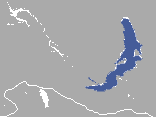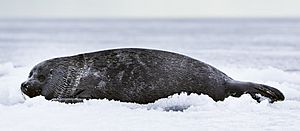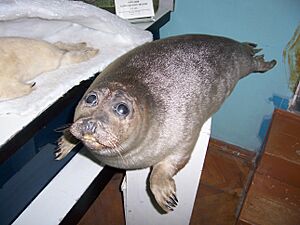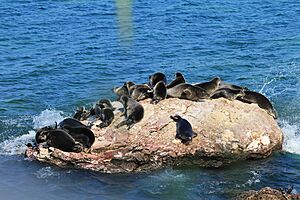Baikal seal facts for kids
Quick facts for kids Baikal seal |
|
|---|---|
 |
|
| Conservation status | |
| Scientific classification | |
| Genus: |
Pusa
|
| Species: |
sibirica
|
 |
|
| Baikal seal range | |
| Synonyms | |
|
Phoca sibirica |
|
The Baikal seal, also called the nerpa (Pusa sibirica), is a special type of seal. It lives only in Lake Baikal in Siberia, Russia. It's related to the Caspian seal and the Arctic ringed seal.
The Baikal seal is one of the smallest seals. It is the only seal species that lives only in fresh water. Other seals, like some harbour seals and ringed seals, can live in fresh water too. But those kinds of seals also have groups that live in the ocean.
Scientists believe there are about 80,000 to 100,000 Baikal seals. This number is healthy for the lake. So, these seals are not currently considered to be in danger.
Contents
What Do Baikal Seals Look Like?
The Baikal seal is one of the smallest true seals. Adult seals are usually about 1.1 to 1.4 meters (3.6 to 4.6 feet) long. They weigh between 63 and 70 kilograms (139 to 154 pounds). The biggest seals found were 1.65 meters (5.4 feet) long and weighed 130 kilograms (287 pounds).
Their weight changes a lot during the year. They are lightest in spring and heaviest in fall. Males and females are almost the same size. Males are only a little bit bigger.
Baikal seals have a uniform, steely-grey coat on their backs. Their bellies are yellowish. Their fur can turn brownish as it gets older. When pups are born, they weigh about 3 to 3.5 kilograms (6.6 to 7.7 pounds). They are about 70 centimeters (2.3 feet) long.
Pups have soft, white fur when they are born. This fur helps them blend in with the snow. They quickly lose this white fur and grow a darker coat, like the adults. Very rarely, some Baikal seals have spotted coats.
Where Do Baikal Seals Live?
Baikal seals live only in the waters of Lake Baikal. It's a bit of a mystery how they first got there. Scientists think they are related to Arctic ringed seals. They might have swum up rivers and streams a long time ago. Or perhaps Lake Baikal was once connected to the ocean during a past ice age.
It is thought that these seals have lived in Lake Baikal for about two million years.
The areas where Baikal seals live in the lake change with the seasons. They are usually alone for most of the year. Sometimes, they live kilometers away from other seals. More seals are found in the northern parts of the lake. This is because the ice stays frozen longer there, which is good for giving birth to pups.
In winter, when the lake freezes, seals make breathing holes in the ice. They stay near these holes. When the ice starts to melt, Baikal seals tend to stay near the shoreline.
How Many Baikal Seals Are There?

Since 2008, the Baikal seal has been listed as a "Least Concern" species. This means they are not currently threatened or endangered. In 1994, Russia estimated there were 104,000 seals. In 2000, a group called Greenpeace counted about 55,000 to 65,000 seals. The most recent estimates are 80,000 to 100,000 animals. This number is considered healthy for the lake.
In the past, the number of seals allowed to be hunted was raised. This happened when the fur industry grew. Also, new ways of hunting, like netting breathing holes, were used. Today, there are rules about how many seals can be hunted. However, some seals are still hunted illegally.
Another issue in Lake Baikal is pollution. Chemicals from factories and farms can get into the lake. These chemicals can weaken the seals' immune systems. This makes them more likely to get sick. For example, a serious illness caused many seal deaths in the late 1980s. Scientists are watching the pollution levels. While Baikal seals currently have lower levels of pollution than seals in some other parts of the world, monitoring is important.
A big future threat to the seals could be global warming. This could change the cold-water environment of Lake Baikal.
The only known natural predator of adult Baikal seals is the brown bear. However, this does not happen often. Seal pups are usually hidden in dens. But they can be hunted by smaller land animals like the red fox or the sable.
Seal Babies and Growing Up
Female Baikal seals can have babies when they are 3 to 6 years old. Males can mate when they are about 4 to 7 years old. Baikal seals mate in the water around the end of winter. Their pregnancy lasts about 11 months.
Female seals usually give birth to one pup. But they are one of only two types of seals that can have twins. Very rarely, triplets or quadruplets have been seen. Twins often stay together for some time after they stop drinking milk from their mother.
Females give birth to their pups on the ice in late winter. They often get pregnant again while still feeding their current pup.
Baikal seals are somewhat polygamous. This means one male might mate with a few females. Males mark the female's den with a strong smell. This lets other males know the den is taken. The female raises the pups by herself. She digs a large den under the ice, up to 5 meters (16 feet) long.
Pups as young as two days old start digging tunnels around the den. This activity helps them get exercise and stay warm. It helps them build up a layer of fat, called blubber, which keeps them warm.
Baikal seal pups drink milk from their mothers for about 2 to 2.5 months. Sometimes, it's up to 3.5 months. During this time, pups can grow to be five times their birth weight. After they stop drinking milk, the mother brings them solid food. This includes small shrimp-like creatures and fish.
In spring, when the ice melts, the dens usually collapse. The pup is then left to find food on its own. Baikal seals continue to grow until they are 20 to 25 years old.
Every year in late winter and spring, both male and female seals shed their old fur. This is called moulting. They grow new fur. While moulting, they often don't eat much. They can become very tired. Sometimes, they can get too hot from lying on the ice in the sun.
During spring and summer, large groups of seals can gather on the ice or shores of Lake Baikal. Baikal seals can live to be over 50 years old. This is very old for a seal! However, females usually only have babies until they are about 30.
What Do Baikal Seals Eat?
Their main food source is a fish called the golomyanka. This oily fish is found only in Lake Baikal. Baikal seals eat more than half of all the golomyanka produced each year. This is about 64,000 tons! In winter and spring, over 90% of their food is golomyanka.
They also eat other fish species. These include Cottocomephorus and Kessler's sculpin. Sometimes, they eat small creatures like shrimp and snails. In autumn, they eat fewer golomyanka. They eat more of the other fish types. A total of 29 different fish species have been found in their diet.
Baikal seals mainly hunt during twilight and at night. This is when golomyanka fish come closer to the surface. During the day, these fish are usually found deeper than 100 meters (328 feet).
Baikal seals can dive very deep, up to 400 meters (1,312 feet). They can stay underwater for more than 40 minutes. Most dives are shorter, usually 2 to 4 minutes. Baikal seals have more blood than other seals their size. This helps them stay underwater longer, up to 70 minutes, if they are scared.
Scientists also found that Baikal seals can filter-feed on small shrimp-like creatures called amphipods. They have special teeth that let them push water out while keeping the amphipods.
During summer nights, seals hunt differently. In the day, they use their eyesight to find fish. At night, when it's dark, they use touch to find crustaceans. These crustaceans move closer to the surface at night. Seals dive deeper at dawn and dusk to catch them as they move.
Baikal seals have been wrongly blamed for drops in another fish called omul. But omul makes up only a tiny part of their diet. The main competitor for omul is the golomyanka. By eating many tons of golomyanka, Baikal seals actually help the omul by reducing competition for food.
Baikal seals have one unusual eating habit. In early autumn, before the lake freezes, they go to bays. They hunt Kessler's sculpin fish there. These fish live in muddy areas and often have grit in their stomachs. When seals eat these fish, the grit helps clean out their digestive system. This helps them get rid of parasites.
Images for kids







